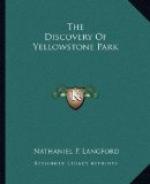Evening of September 4.—I have been glad to have this rest to-day, for with the time spent in writing up a detailed diary in addition to the work about camp, I have been putting in about sixteen hours work each day. So this afternoon a nap of two or three hours was a pleasant rest. I strolled for a long distance down the shore, the sand of which abounds in small crystals, which some of our party think may possess some value. Craters emitting steam through the water are frequently seen beneath the surface, at a distance of from forty to fifty feet from its margin, the water in which is very hot, while that of the lake surrounding them I found to be too cool for a pleasant bath. In some places the lake water is strongly impregnated with sulphur. One crater emits a jet of steam with a hissing noise as loud as that usually heard at the blowing off of the safety valve of a steam-boat. In the clear light of the setting sun, we can see the three Tetons in a southwesterly direction.
[Illustration: GRAND TETON.]
Some member of our party has asked what is the meaning of the word “Teton” given to these mountains.[L] Lieutenant Doane says it is a French word signifying “Woman’s Breast,” and that it was given to these mountains by the early French explorers, because of their peculiar shape. I think that the man who gave them this name must have seen them from a great distance; for as we approach them, the graceful curvilinear lines which obtained for them this delicate appellation appear angular and ragged. From our present point of view the name seems a misnomer. If there were twelve of them instead of three, they might better be called the “Titans,” to illustrate their relation to the surrounding country. He indeed must have been of a most susceptible nature, and, I would fain believe, long a dweller amid these solitudes, who could trace in these cold and barren peaks any resemblance to the gentle bosom of woman.




